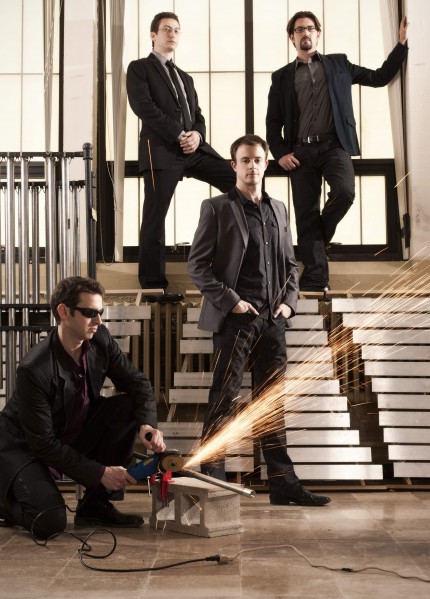Third Coast Percussion delivers powerful Thomas premiere at Logan Center

It must have been heartening for contemporary music aficionados to see a nearly full house for Third Coast Percussion at the Logan Center in Hyde Park Friday. A major draw at the University of Chicago Presents event was the highly anticipated local premiere of Augusta Read Thomas’ Resounding Earth, written for the quartet in 2012 and already the focus of a highly acclaimed recording.
The back story of the piece makes for a program annotator’s dream. Since the bells at the heart of the music have been a conceptual focus of much of Thomas’ oeuvre, this ambitiously proportioned four-movement work could be viewed as a significant touchstone in her illustrious quarter-century career. A true composer/performer collaboration, it draws on the astonishing range of over 200 bells collected by the ensemble from around the globe, and over 300 pieces of metal in total. For all of the sonic sourcing from Asian locales, each of the four movements is also an homage to giants of Western composition. Even by modern multicultural standards, the accumulation of sound and ritual is truly encyclopedic.
This is a lot of baggage to carry, but Thomas pulls it off triumphantly. The clear, semi-dry acoustics of Logan Center were a perfect fit for the strike-and-decay sonic profile, and the players threw themselves into their realization with obvious affection for both the composer and the centuries of musical traditions that shaped each instrument. While the work reflects Thomas’ reverence for these cultural symbols, she shows no reticence in coaxing novel timbres from the vast array. A lesser composer might have drowned under the stress of such a profusion of sonic possibilities, but Thomas neatly matched each rhythmic gesture to an appropriate sound and dynamic.
The opening movement (“Invocation – Pulse Radiance”) is an homage to Stravinsky and Messiaen, and a compelling fusion of the former’s primal rhythmic thrust with the later’s celebrations of glistening iridescence. The flickering resonances of Burmese spinning gongs announced the opening of “Mantra – Ceremonial Time Shapes”, inspired by Lou Harrison and György Ligeti. The sound world conjured in “Reverie-Crystal Lattice” was the most forceful and comprehensive of the four movements, and a final solitary strike on four chimes from the stage front made for an ingenious and compelling conclusion.
The most memorable movement was in some respects also the simplest: “Prayer – Star Dust Orbits”, an homage to Luciano Berio and Pierre Boulez. The featured instruments were temple bowls, mostly struck but also slowly rubbed along their circumference to produce an utterly beguiling metallic song. The periodic accumulation of sustained clouds of dissonance made for one of the most powerful new music experiences I’ve felt in years.
The concert began with John Cage’s Third Construction from 1941, a staple of the quartet’s repertoire and among the first Western works conceived for a percussion ensemble. With a steady pulse, infectious syncopations, formal clarity, and deftly timed color shifts, this is one of those early works from the composer that even Cage-haters admire. While not as ambitiously colored as Thomas’ work, the variety of instruments and timbres is sizable. Some were relatively routine (tambourine, cowbells, tom toms) while others were of the “found” variety (tin cans, split bamboo). The attention grabber was the lion’s roar, which on this occasion sounded less like the giant feline and more like an elephant seal during mating season. Playing from memory, the quartet gave a sparkling and vivid performance, each player moving among the battery with grace, fluidity, and palpable pleasure.
Unlike Chen Yi, Zhou Long, and Tan Dun, Guo Wenjing was one of the few members of Beijing’s Central Conservatory of Music’s famed “Class of ’78” to remain in China. His trio Parade, while not as central to percussion ensemble literature as Cage’s quartet, has nevertheless been taken up by many of Third Coast’s predecessors. Composed for six Beijing opera gongs, the instrumentation is as narrow as the Cage and Thomas are expansive. The title is a pun signifying both “glitter” and “display”, a reference to the virtuosity and tight choreography required by the three players.
Nearly as tied to pulse as the Cage, the work holds as much interest visually as it does musically, a trait exploited in this performance by video projections from a camera suspended above the players. The were moments when gestures began to wear out their welcome, but in general it came off well, a sonic study that drew upon every skill of this dextrous foursome (Sean Connors, Robert Dillon, Peter Martin, and David Skidmore).
Posted in Performances




